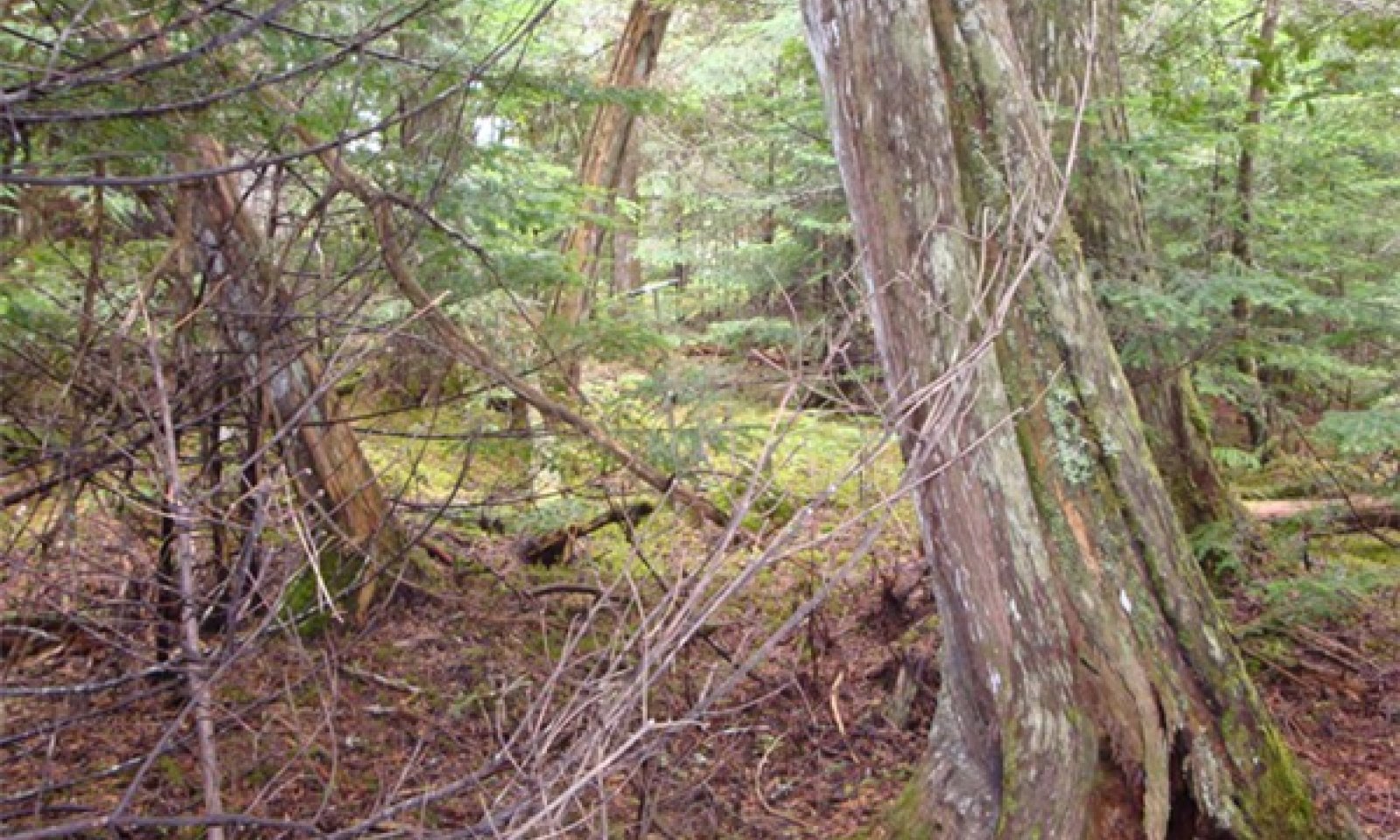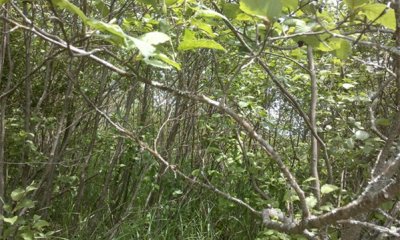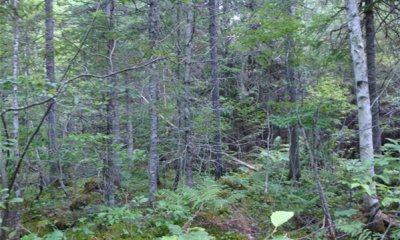
Marine Terrace Depression
Scenario model
Current ecosystem state
Select a state
Management practices/drivers
Select a transition or restoration pathway
- Transition T1A More details
- Transition T1B More details
- Restoration pathway R2A More details
- Restoration pathway R2B More details
- Restoration pathway R3A More details
- Transition T3A More details
-
No transition or restoration pathway between the selected states has been described
Target ecosystem state
Select a state
State 1
Reference






Description
The forested plant community phase (1.1) has a medium to dense canopy cover, averaging 85 percent and ranges from 75 to 95 percent. It consists of a stratified mixture of conifer and northern hardwood tree species. Northern white cedar (Thuja occidentalis) forms a canopy over other codominant or intermediate species such as red spruce (Picea rubens), except along the coast, red maple (Acer rubrum), gray birch (Betula populifolia), black ash (Fraxinus nigra), balsam fir (Abies balsamea), black spruce (Picea mariana), and tamarack (Larix laricina). Some sites have more red spruce or red maple depending on their previous forest management or location.
The understory may be sparse due to a dense conifer overstory cover except for small open areas, less than a 0.1 of an acre, where a wide variety of forbs, ferns, and shrubs grow. Under the dense conifer overstory, only small scattered shade-tolerant and moisture-loving plants grow. Plants include balsam fir regeneration, a few sedges, and many species of feather-mosses and leafy liverworts. The moss grows over the mounds, on downed dead wood, and the bottoms of trees throughout this site. Due to the dense, shady, understory tall shrubs are almost non-existent. In the small open areas, taller shrubs, such as speckled alder (Alnus incana), are present along with wild sarsaparilla (Aralia nudicaulis) and dwarf red raspberry (Rubus pubescens). Clumps of cinnamon fern (Osmunda cinnamomea) and small patches of sensitive fern (Onoclea sensibilis) are also common on the mounds. Small forbs usually found on hummocks include maystar (Trientalis borealis), blue-bead lily (Clintonia borealis), and bunchberry (Cornus canadensis). Eastern poison-ivy may also be present on some sites and should be avoided because it can cause severe dermatitis. On one sample site, skunk cabbage (Symplocarpus foetidus) was abundant in the pools of water. Very few grass or grass-like plant species were found on this site. There were more sedges than grasses and both appeared in small clumps on mounds scattered throughout. Typical sedges include three-seeded sedge (Carex trisperma).
Submodel
Description
The ponded state is a result of beaver activity. This state is frequently ponded for long durations. The description is based on historical descriptions, site index data, professional consensus of experienced ecologists, and analysis of field work. This state is perceived to be a mixture of shrubs, typically speckled alder (Alnus incana) and graminoids, such as tussock (upright) sedge (Carex stricta) with few if any mature trees because they have been drowned out or eaten by the beavers.
Submodel
State 3
Harvested





Description
The harvested state is quite common in Maine. Most harvesting is by an individual tree or group selection method in this MLRA and on this site. The reference forest has been harvested for the most desirable species, northern red cedar and spruce. The remaining forest stand consists of young red maple and gray birch with a few balsam fir, tamarack, and black ash. This state is most like the reference state in plant composition particularly in the understory if only small openings are created like for an individual tree selection harvest. Group selection harvests may make larger openings temporarily that will allow other species to grow for very short periods of time. If northern red cedar and red spruce are harvested in large quantities, the harvested state will become dominated by red maple and other faster growing species.
Submodel
Mechanism
The reference state may transition to a flooded state from the effects of beavers on the hydrology of a site. Beavers can cause a long term elevation of ponded water and the killing of nearby trees for food. This will eliminate trees and favor the growth of shrubs such as speckled alder, forbs, grasses, and grass-like plant species.
Mechanism
The reference state transitions to a harvested state by the removal of some or all desirable woody vegetation. Hydrology may be moderately to severely altered by the addition of woody debris or gravel in forest access trails and roads in narrow linear locations throughout the site if done at the wrong time of year or at inappropriate times, such as during or after heavy rainfalls.
Mechanism
The ponded state may transition to a reference state by the elimination of beavers and their dams, and allowing the return after many years of normal hydrology that will favor trees. Tree and shrub planting might also be used to speed up the process.
Relevant conservation practices
| Practice | External resources |
|---|---|
|
Obstruction Removal |
|
|
Tree/Shrub Establishment |
Mechanism
The ponded state may transition to a harvested state by the elimination of beavers and their dams, and allowing the return after many years of normal hydrology that will favor trees. Tree and shrub planting might also be used to speed up the process. This would only be an intermediate step towards a fully restored site and would not be commonly used.
Relevant conservation practices
| Practice | External resources |
|---|---|
|
Obstruction Removal |
|
|
Tree/Shrub Establishment |
Mechanism
The harvested state may be restored to the reference state by natural regeneration over a period of time or the planting of desirable vegetation which may shorten the period of time to full canopy status. Invasive species establishment and wildlife damage to plants must be controlled in order to fully restore the site.
Relevant conservation practices
| Practice | External resources |
|---|---|
|
Brush Management |
|
|
Tree/Shrub Establishment |
Mechanism
The harvested state may transition to a flooded state from the effects of beavers on the hydrology of a site. Beavers can cause a long term elevation of ponded water and the killing of nearby trees for food. This will eliminate trees and favor the growth of shrubs, forbs, and grasses.
Model keys
Briefcase
Add ecological sites and Major Land Resource Areas to your briefcase by clicking on the briefcase (![]() ) icon wherever it occurs. Drag and drop items to reorder. Cookies are used to store briefcase items between browsing sessions. Because of this, the number of items that can be added to your briefcase is limited, and briefcase items added on one device and browser cannot be accessed from another device or browser. Users who do not wish to place cookies on their devices should not use the briefcase tool. Briefcase cookies serve no other purpose than described here and are deleted whenever browsing history is cleared.
) icon wherever it occurs. Drag and drop items to reorder. Cookies are used to store briefcase items between browsing sessions. Because of this, the number of items that can be added to your briefcase is limited, and briefcase items added on one device and browser cannot be accessed from another device or browser. Users who do not wish to place cookies on their devices should not use the briefcase tool. Briefcase cookies serve no other purpose than described here and are deleted whenever browsing history is cleared.
Ecological sites
Major Land Resource Areas
The Ecosystem Dynamics Interpretive Tool is an information system framework developed by the USDA-ARS Jornada Experimental Range, USDA Natural Resources Conservation Service, and New Mexico State University.



